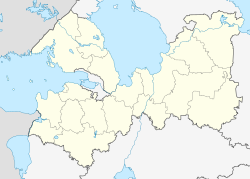Kingisepp
| Kingisepp (English) Кингисепп (Russian) |
|
|---|---|
| - Town - | |
 Views of Kingisepp |
|
 Location of Leningrad Oblast in Russia |
|
|
|
|
|
|
|
|
|
|
| Administrative status (as of June 2013) | |
| Country | Russia |
| Federal subject | Leningrad Oblast |
| Administrative district | Kingiseppsky District |
| Settlement municipal formation | Kingiseppskoye Settlement Municipal Formation |
| Administrative center of | Kingiseppsky District, Kingiseppskoye Settlement Municipal Formation |
| Municipal status (as of May 2010) | |
| Municipal district | Kingiseppsky Municipal District |
| Urban settlement | Kingiseppskoye Urban Settlement |
| Administrative center of | Kingiseppsky Municipal District, Kingiseppskoye Urban Settlement |
| Statistics | |
| Population (2010 Census) | 48,488 inhabitants |
| - Rank in 2010 | 327th |
| Time zone | MSK (UTC+03:00) |
| First mentioned | 1384 |
| Previous names |
Yam (until May 14, 1703), Yamburg (until 1922) |
| Postal code(s) | 188480, 188482, 188485, 188487, 188489, 188499 |
| Dialing code(s) | +7 81375 |
|
|
|
| on | |
Kingisepp (Russian: Ки́нгисепп or Кингисе́пп; Finnish: Jaama), formerly Yamburg (Я́мбург), Yam (Ям), and Yama (Я́ма), is an ancient town and the administrative center of Kingiseppsky District of Leningrad Oblast, Russia, located along the Luga River 138 kilometers (86 mi) southwest of St. Petersburg, 20 kilometers (12 mi) east of Narva, and 40 kilometers (25 mi) south of the Gulf of Finland. Population: 48,488 (2010 Census);50,295 (2002 Census);49,954 (1989 Census).
The town was first documented in 1384, when the Novgorodians under Patrikas built there a fortress against the Swedes. It was called Yama or Yamsky Gorodok, after the Ingrian (ethnic Finnic group) name Jaama. The environs of the town are still cited as the main location of speakers of the nearly extinct Ingrian language. The citadel withstood sieges by the Swedes in 1395 and by the Teutonic Knights during the 1444–1448 war.
The town became the most important economic center of the Vodskaya pyatina of the Novgorod Republic. There were 201 homesteads in the 15th century in the town; its total population can only be evaluated roughly based on the estimates of three to five persons per homestead. At the end of the Livonian War, it was ceded to Sweden, only to be returned twelve years later, in 1595.
...
Wikipedia



